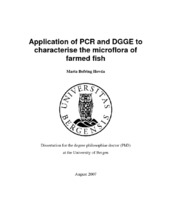Application of PCR and DGGE to characterise the microflora of farmed fish
Doctoral thesis
Permanent lenke
https://hdl.handle.net/1956/2520Utgivelsesdato
2007-11-09Metadata
Vis full innførselSamlinger
Sammendrag
Farming of fish has become an increasingly important part of the Norwegian fishing industry. Furthermore, the Norwegian fishing sector represents one of the largest national industries in terms of economic value. Fish is a perishable product and a suitable substrate for chemical degradation and bacterial growth. Determinations of shelf-life of fish and fish products have traditionally been based on microbial, chemical and sensory evaluation. It is, however, important to have methods for a rapid and reliable assessment of the microflora, and to aid in the determination of the shelf-life of the fish products. This thesis discusses and describes the use of PCR and denaturing gradient gel electrophoresis (DGGE) to detect and characterise the microflora of farmed Atlantic halibut and cod. The aims were to introduce and apply molecular biological methods for characterisation of the microflora, and to use these methods to detect the changes in the microflora as a function of shelf-life extending treatments. An additional aim was to compare the results obtained from molecularbased and culture-based methods. The DGGE and subsequent sequencing approach displayed the bacterial flora of the farmed fish, and identified the predominant microflora. When applying the sequencing approach, Photobacterium spp., Pseudomonas spp., Brochothrix thermosphacta, Serratia sp., Yersinia sp., Micrococcus luteus and Shewanella spp. were found to be the predominant bacteria in farmed Atlantic cod and halibut, stored under modified atmosphere (MA). The method detected a more diverse bacterial flora than previously obtained when culture-based methods were applied. Bacterial DNA extracted directly from the sample, without prior cultivation, gave a more diverse bacterial community. Furthermore, the molecular methods have been used to study the effects of MA packaging and ozone treatment on the microflora composition. There was no observable effect of ozone treatment of farmed cod.
Består av
Paper I: Food Microbiology, 24, Hovda, Maria B.; Sivertsvik, M.; Lunestad, B. T.; Lorentzen, G. & Jan Thomas Rosnes, Characterisation of the dominant bacterial population in modified atmosphere packaged farmed halibut (Hippoglossus hippoglossus) based on 16S rDNA-DGGE, pp. 362-371. Copyright 2007 Elsevier Ltd. Full text not available in BORA due to publisher restrictions. The published version is available at: http://dx.doi.org/10.1016/j.fm.2006.07.018Paper II: International Journal of Food Microbiology, 117, Hovda, Maria B.; Lunestad, B. T.; Sivertsvik, M. & Jan Thomas Rosnes, Characterisation of the bacterial flora of modified atmosphere packaged farmed Atlantic cod (Gadus morhua) by PCR-DGGE of conserved 16S rRNA gene regions, pp. 68-75. Copyright 2007 Elsevier B.V. Full text not available in BORA due to publisher restrictions. The published version is available at: http://dx.doi.org/10.1016/j.ijfoodmicro.2007.02.022
Paper III: Journal of Food Protection, 70(11), Hovda, Maria B.; Sivertsvik, M.; Lunestad, B. T. & Jan Thomas Rosnes, Modified-Atmosphere-Packaged Farmed Cod Fillets, pp. 2460-2465(6). Copyright 2007 International Association For Food Protection. Full text not available in BORA due to publisher restrictions. The published version is available at: http://www.ingentaconnect.com
Paper IV: Agriculture 272(1-4), Hovda, Maria B.; Lunestad, B. T.; Fontanillas, R. & Jan Thomas Rosnes, Molecular characterisation of the intestinal microbiota of farmed Atlantic salmon (Salmo salar L.), pp. 581-588. Copyright 2007 Elsevier B.V. Full text not available in BORA due to publisher restrictions. The published version is available at: http://dx.doi.org/10.1016/j.aquaculture.2007.08.045
